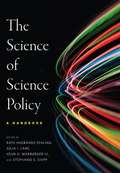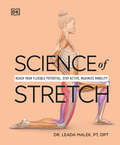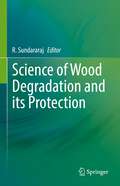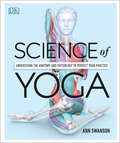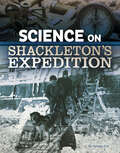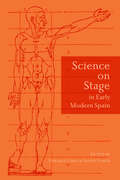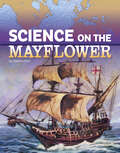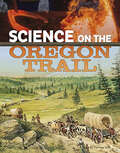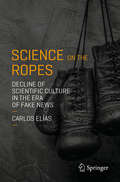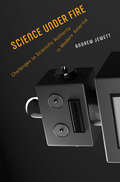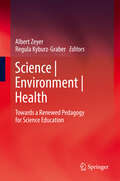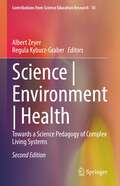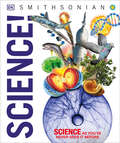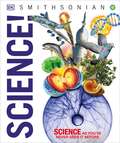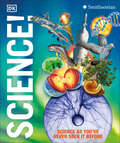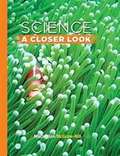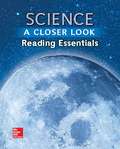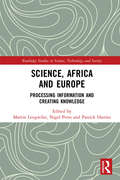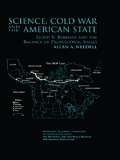- Table View
- List View
Science of Science and Innovation Policy
by Kaye Husbands FealingBasic scientific research and technological development have had an enormous impact on innovation, economic growth, and social well-being. Yet science policy debates have long been dominated by advocates for particular scientific fields or missions. In the absence of a deeper understanding of the changing framework in which innovation occurs, policymakers cannot predict how best to make and manage investments to exploit our most promising and important opportunities. Since 2005, a science of science policy has developed rapidly in response to policymakers' increased demands for better tools and the social sciences' capacity to provide them. The Science of Science Policy: A Handbook brings together some of the best and brightest minds working in science policy to explore the foundations of an evidence-based platform for the field. The contributions in this book provide an overview of the current state of the science of science policy from three angles: theoretical, empirical, and policy in practice. They offer perspectives from the broader social science, behavioral science, and policy communities on the fascinating challenges and prospects in this evolving arena. Drawing on domestic and international experiences, the text delivers insights about the critical questions that create a demand for a science of science policy.
Science of Stretch: Reach Your Flexible Potential, Stay Active, Maximize Mobility (DK Science of)
by Dr. Leada MalekExplore new movements and alleviate stiff joints with more than 100 exercises designed to keep you flexible, energized, and active for life. Pain and stiffness can create fear and uncertainty in our ability to move, affecting quality of life. Exercise has continuously proven to be beneficial against disease, yet people are becoming increasingly sedentary.More than a quarter of the world's population is insufficiently active and it's time we remove barriers to exercise and encourage movement exploration. The Science of Stretch is your guide to understanding the human body's resilient and adaptable nature and how stretching can play a role in achieving your highest well-being.Inside the pages of this book you'll learn about:-The latest research on stretching-Human anatomy and physiology-The nervous system and pain science-How to reduce injury risk with exercise-Managing a lifestyle catered towards healthy aging-What happens to the body when we stretch-Different types of stretching and how to implement them to best compliment your daily life or sporting activities-Finally, a series of suggested stretch routines are outlined, each with a progressive increase in challenge and tailored to different abilities and fitness objectives-alongside the tools to create your own bespoke workouts.Every exercise is anatomized in detail to make movement easily understood using CGI artworks to show how each muscle is correctly activated and each joint aligned. Whether you're taking a walk around the park or running a marathon, Science of Stretch will help you stay flexible, keep active, and remove the uncertainty from stretching.
Science of Wood Degradation and its Protection
by R. SundararajThis edited book covers all aspects of wood degradation from its formation and growing in trees to its end usages when it is put into human usage. Wood is an age-old traditional fascinating material with a sensory-rich immersive experience that kindles aesthetics and creativity. The utility, durability, and functionality of wood render it a cosmopolitan material. It constitutes an integral part of human lives from ancient times to modern societies being used by various sectors viz., construction, furniture, panel products, paper and pulp, sports goods, agricultural implements, etc., Wood, being a biological material, is susceptible to degradation both by physical and biological means, and the need to protect the wood and prevent heavy economic losses constitutes a major challenge. Also, wood formed by the trees is the major sinks of carbon and the carbon remains locked-up for the life of the wood, thereby serving as important tool to mitigate the climate change. But the carbon stored in wood returns to the atmosphere when it degrades and will have positive effect on climate change. Hence, wood protection aiming for extending the service life of wood plays a key role in locking the carbon for a longer period in the wood and also substantially reduce the demand and depletion of forest resources. The book focuses on wood as an important natural bio-resource, inventory of wood protection, usage, utilization, preservatives, protection technologies and wood protection from all forms of degradation. Special focus is given on the eco-friendly way of protecting wood and its importance in mitigating climate change. The book is useful for Indian and international readers, who are working in wood domains. It is of interest to wood technologists, teachers, researchers, climate change scientists, capacity builders, and policymakers. It is of immense importance as a guide and study material to the graduate and postgraduate students of wood science in various universities of India and abroad.
Science of Yoga: Understand the Anatomy and Physiology to Perfect Your Practice (Dk Science Of Ser.)
by Ann SwansonExplore the biomechanics of 30 key yoga asanas, in-depth and from every angle, and master each pose with confidence and control.Introducing Science of Yoga - an all-encompassing science book to help you better understand yoga anatomy and the medical science behind yoga to perfect your practice and poses!Did you know that yoga practice can help treat age-related memory loss better than brain-training games? Recent scientific research now supports what were once anecdotal claims about the benefits of yoga to every system in the body. Science of Yoga provides a detailed insight into variations of key yoga poses and the specific benefits of different styles of yoga on the human body, system by system. Dive right in to discover: - Specially commissioned CGI artworks show 30 asanas in depth and detail the physics of the pose - 16 spreads of clear, easy-to-understand scientific facts and research answering key questions around ancient and modern claims - Illustrated section on the benefits of yoga on the human body system by system - Easy-to-understand research is presented in an easy-to-understand format with illustrated pullouts, debunking the myths and explaining the scientific facts, from breathing techniques to mindfulnessScience of Yoga is a riveting read, and reveals how your blood flow, respiration, muscles and joints work below the surface of each yoga pose, whilst teaching you to achieve technical excellence in your practice, from the comfort of your own home.The first yoga book on the market to combine detailed anatomical drawings, pose mechanics and key scientific research, Science of Yoga is a must-have volume for yoga beginners and professionals alike, seeking an accessible and easy-to-read guide on the effects of yoga on the human body from a scientific standpoint. Whether you&’re looking to take up yoga this New Year, or your yoga poses are already perfect, this science book is the ideal fitness gift for the yoga lover in your life, and sets out to separate the facts of yoga from the myths, with proven scientific research.
Science of the Physical Creation in Christian Perspective (2nd Edition)
by Dewitt Steele Gregory ParkerTopics covered in this text book include atmosphere, weather, seas, molecules, weathering , erosion , waves , sound, light , color and many more.
Science on Shackleton’s Expedition (The Science of History)
by Tammy EnzSir Ernest Henry Shackleton led an expedition across Antarctica in 1914. Did you know that science played a big role in this dangerous journey? Learn how weather patterns affected the explorer in Antarctica. Find out the science behind Shackleton’s ship, The Endurance. And discover how modern technology is being used to find out even more about this adventure more than 100 years later.
Science on Stage in Early Modern Spain (Toronto Iberic)
by Enrique Garcia Santo-TomasScience on Stage in Early Modern Spain features essays by leading scholars in the fields of literary studies and the history of science, exploring the relationship between technical innovations and theatrical events that incorporated scientific content into dramatic productions. Focusing on Spanish dramas between 1500 and 1700, through the birth and development of its playhouses and coliseums and the phenomenal success of its major writers, this collection addresses a unique phenomenon through the most popular, versatile, and generous medium of the time. The contributors tackle subjects and disciplines as diverse as alchemy, optics, astronomy, acoustics, geometry, mechanics, and mathematics to reveal how theatre could be used to deploy scientific knowledge. While Science on Stage contributes to cultural and performance studies it also engages with issues of censorship, the effect of the Spanish Inquisition on the circulation of ideas, and the influence of the Eastern traditions in Spain.
Science on the Mayflower (The Science of History)
by Tammy EnzYou may have heard of the Mayflower. The ship set sail in 1620, carrying English pilgrims across the sea to Plymouth. But did you know that science played a big role in this voyage? Learn how the Mayflower was constructed. Find out how science helped sail the ship across the ocean. And discover how modern technology is being used to understand the journey and the people aboard.
Science on the Oregon Trail (The Science of History)
by Tammy EnzYou may have heard of the Oregon Trail. In the 1840s, more than 5,000 people traveled the Oregon Trail, hoping for a better life. But did you know that science played a big role in this epic journey? Learn how covered wagons were engineered. Find out how food was preserved and diseases were treated along the trail. And discover how modern technology is helping us learn even more about this time in history.
Science on the Roof of the World: Empire and the Remaking of the Himalaya (Science in History)
by Lachlan FleetwoodWhen, how, and why did the Himalaya become the highest mountains in the world? In 1800, Chimborazo in South America was believed to be the world's highest mountain, only succeeded by Mount Everest in 1856. Science on the Roof of the World tells the story of this shift, and the scientific, imaginative, and political remaking needed to fit the Himalaya into a new global scientific and environmental order. Lachlan Fleetwood traces untold stories of scientific measurement and collecting, indigenous labour and expertise, and frontier-making to provide the first comprehensive account of the East India Company's imperial entanglements with the Himalaya. To make the Himalaya knowable and globally comparable, he demonstrates that it was necessary to erase both dependence on indigenous networks and scientific uncertainties, offering an innovative way of understanding science's global history, and showing how geographical features like mountains can serve as scales for new histories of empire.
Science on the Ropes: Decline of Scientific Culture in the Era of Fake News
by Carlos ElíasIn this controversial essay, Carlos Elías addresses the worldwide phenomenon that is threatening the scientific and economic progress of Western countries. The rise and influence of magic and irrationality in the media, in social networks and at universities is a disturbing phenomenon: many Western students no longer want to pursue STEM (Science, Technologies, Engineering, and Math) careers. This lucid and well-written book addresses one of the key issues of public debate: the deteriorating state of science in Western countries and their governments, and its rise in Asian countries. The author compares two distinct models: the Spanish or Latin model, which closed the door on science with the Counter-Reformation, and that employed by a second group of countries where science was encouraged. Elías suggests that a similar development could now be taking place between Western countries (where the press, television and social science academics are becoming increasingly critical towards science) and Asia, where most prime ministers (and other politicians) are scientists or engineers. This book is intended for STEM educators (both at secondary schools and universities), scientists and academics interested in scientific culture in the era of fake news.
Science under Fire: Challenges to Scientific Authority in Modern America
by Andrew JewettAmericans have long been suspicious of experts and elites. This new history explains why so many have believed that science has the power to corrupt American culture. Americans today are often skeptical of scientific authority. Many conservatives dismiss climate change and Darwinism as liberal fictions, arguing that “tenured radicals” have coopted the sciences and other disciplines. Some progressives, especially in the universities, worry that science’s celebration of objectivity and neutrality masks its attachment to Eurocentric and patriarchal values. As we grapple with the implications of climate change and revolutions in fields from biotechnology to robotics to computing, it is crucial to understand how scientific authority functions—and where it has run up against political and cultural barriers. Science under Fire reconstructs a century of battles over the cultural implications of science in the United States. Andrew Jewett reveals a persistent current of criticism which maintains that scientists have injected faulty social philosophies into the nation’s bloodstream under the cover of neutrality. This charge of corruption has taken many forms and appeared among critics with a wide range of social, political, and theological views, but common to all is the argument that an ideologically compromised science has produced an array of social ills. Jewett shows that this suspicion of science has been a major force in American politics and culture by tracking its development, varied expressions, and potent consequences since the 1920s. Looking at today’s battles over science, Jewett argues that citizens and leaders must steer a course between, on the one hand, the naïve image of science as a pristine, value-neutral form of knowledge, and, on the other, the assumption that scientists’ claims are merely ideologies masquerading as truths.
Science v. Story: Narrative Strategies for Science Communicators
by Emma Frances BloomfieldUncovering common threads across types of science skepticism to show why these controversial narratives stick and how we can more effectively counter them through storytelling Science v. Story analyzes four scientific controversies—climate change, evolution, vaccination, and COVID-19—through the lens of storytelling. Instead of viewing stories as adversaries to scientific practices, Emma Frances Bloomfield demonstrates how storytelling is integral to science communication. Drawing from narrative theory and rhetorical studies, Science v. Story examines scientific stories and rival stories, including disingenuous rival stories that undermine scientific conclusions and productive rival stories that work to make science more inclusive. Science v. Story offers two tools to evaluate and build stories: narrative webs and narrative constellations. These visual mapping tools chart the features of a story (i.e., characters, action, sequence, scope, storyteller, and content) to locate opportunities for audience engagement. Bloomfield ultimately argues that we can strengthen science communication by incorporating storytelling in critical ways that are attentive to audience and context.
Science | Environment | Health: Towards a Renewed Pedagogy for Science Education (Contemporary Trends and Issues in Science Education)
by Albert Zeyer Regula Kyburz-GraberHealth and the environment are important learning areas in science education and their significance is growing. Not only do they have high social relevance, but they are also close to students' interests and needs. They provide many opportunities to unlock science with questions that are personally relevant to boys and girls and that inspire them to engage in science. This book contains a selection of papers from prominent professionals in science, health and environmental education, who reflect on science education, each from their specific point of view. The core idea is to present well-founded perspectives on how science education may benefit from challenges stemming from both health and environmental education. Specific reasons are discussed as to why these two areas are particularly legitimized to challenge science education, and their potential impact on a revision of science education is evaluated. A new pedagogy for science¦environment¦health that yields interesting and relevant science education for students and teachers, and addresses the grand challenges of this century: what an attractive and rewarding project! The book will motivate teachers, teacher educators and science education researchers to take part in this on-going project.
Science | Environment | Health: Towards a Science Pedagogy of Complex Living Systems (Contributions from Science Education Research #10)
by Albert Zeyer Regula Kyburz-GraberThis book provides a fascinating insight into the on-going process of self- reflection in the Science|Environment|Health (S|E|H) community. The basic vision of a new S|E|H pedagogy is to establish a transdisciplinary dialogue between the three educational fields of science education, environmental education, and health education. This approach finds growing interest among science educators. Since 2014, the ESERA special interest group S|E|H has united both experienced and junior researchers all over Europe in a burgeoning research community.This book presents a selection of results of these vibrant activities. Systems theory has turned out to be a stimulating theoretical framework for S|E|H. The limits of predictability in complex living systems result in structural uncertainty for decision-making, and they ask for emphasising and rethinking the role of pedagogical concepts like informed citizenship and scientific literacy. They challenge crude scientific determinism in environmental and health education, which all too often ends up with students’ eco- and health depression. Instead, S|E|H conceives coping with uncertainty in terms of an interplay between cognitive and affective factors. The horizon of the future remains always open. Hope must never die in a new S|E|H pedagogy.Chapter 3 is available open access under a Creative Commons Attribution 4.0 International License via link.springer.com.
Science! (DK Knowledge Encyclopedias)
by DKExplore science as you&’ve never known it before with this children's encyclopedia perfect for budding scientists!Forming part of a fantastic series of kid's educational books, this bold and brilliant kid's encyclopedia uses ground-breaking CGI imagery to reveal the world as you've never seen it before. Informative, diverse in subject matter, easy-to-read and brimming with beautiful graphics, young learners can explore the incredibly detailed cross-sections and cutaways that reveal the scientific inner workings of just about everything!This charming children&’s encyclopedia opens the world in new ways, with: - Packed with facts, charts, timelines, and infographics that cover a vast range of topics. - Encompassing a visual approach with illustrations, photographs and extremely detailed 3D images.- Crystal clear text distills the key information.- DK's encyclopedias are fact-checked by subject experts to offer accuracy beyond online sources of information.This fully-updated edition of Knowledge Encyclopedia Science! is the perfect encyclopedia for children aged 9-12, ideal for inquisitive minds, providing young readers with an engaging introduction to core science topics, demonstrating how all the major scientific principles fit together and using awe-inspiring illustrations to reveal how biology, chemistry and physics is used every day in the world around us. Jam-packed with spectacular scientific facts, including graphics, facts, and data boxes, this science encyclopedia is sure to delight budding young scientists. Explore, Discover And Learn!DK's Knowledge Encyclopedia Science! uncovers the marvels of our world in unprecedented detail and with stunning realism. Encompassing incredible computer-generated images to reveal and explain science as never before, you can spend quality time exploring the world of science with your children, whether it&’s looking inside a cell, pulling apart a Formula 1 racing car, or examining the forces that hold the Universe together, accompanied by impressive visuals to engage their senses. A must-have volume for curious kids with a thirst for knowledge, this enthralling encyclopedia is structured in such a way that your child can read a bit at a time, and feel comfortable to pause and ask questions. Doubling up as the perfect gift for young readers, who are always asking questions about the inner workings of our planet! At DK, we believe in the power of discovery. This thrilling kid&’s encyclopedia is part of the Knowledge Encyclopedia educational series. Celebrate your child&’s curiosity as they complete the collection and discover diverse facts about the world around them. Dive into the deep blue with Knowledge Encyclopedia Ocean! Travel back in time to when dinosaurs roamed the earth with Knowledge Encyclopedia Dinosaur! And hone your knowledge on how the human body works with Knowledge Encyclopedia Human Body! Whatever topic takes their fancy, there&’s an encyclopedia for everyone!
Science! (Knowledge Encyclopedias)
by DkForming part of a fantastic series of kid's educational books, this bold and brilliant kid's encyclopedia uses ground-breaking CGI imagery to reveal the world as you've never seen it before. Informative, diverse in subject matter, easy-to-read and brimming with beautiful graphics, young learners can explore the incredibly detailed cross-sections and cutaways that reveal the scientific inner workings of just about everything!
Science!, 2nd Edition (DK Knowledge Encyclopedias)
by DKDK’s best-selling richly illustrated encyclopedia series explores the wonderful world of science.Learn the ins and outs of science as you’ve never seen it before, through incredibly detailed 3D illustrations, in this encyclopedia for children aged 9+.Knowledge Encyclopedia’s clear explanations, illustrations, photographs, and 3D images will engage children in complex subjects. Learn about hundreds of vehicles that float, fly, or speed across the land, including the record breakers—the fastest, largest, longest, and strangest modes of transportation ever to zoom, sail, or soar.This all-encompassing science encyclopedia for kids offers: An impressive collection of facts, charts, timelines, and illustrations.A visual approach using illustrations, photographs, and extremely detailed 3D CGI images.Clear explanations of physics, chemistry, and biology, as well as space exploration, the latest technology, wonderful wildlife, and our amazing bodies.Children can explore science in a new and exciting way. Learn about groundbreaking topics like looking inside a cell, pulling apart the ever-present electronics in our lives to see how they work, showing how ships stay afloat, and examining the forces that hold the Universe together. This impressively detailed encyclopedia uses awesome illustrations to show biology, chemistry, and physics in the world around us. All the essential information in easy-to-read text with additional fun facts, and brought to life with amazing 3D illustrations that look inside the anatomy of a blue whale, zoom into a molecule of water, and out of the Solar System.More in the seriesKnowledge Encyclopedia Science! is part of DK’s visual and hugely successful Knowledge Encyclopedia series. Complete the collection and dive into the deep with Knowledge Encyclopedia Ocean!, take a trip to the solar system with Knowledge Encyclopedia Space! and travel back to prehistoric times with Knowledge Encyclopedia Dinosaur!
Science, Social Science class 6 - Tamil Nadu Board
by Tamil GovernmentThe Science textbook for standard six has been prepared following the guidelines given in the National Curriculum Framework 2005. The book is designed to maintain the paradigm shift from the primary General Science to branches as Physics, Chemistry, Botany and Zoology.
Science, A Closer Look (Elementary Science Closer Look Ser. #3)
by McGraw-Hill EducationThe Grade 3 Student Edition covers units such as Ecosystems, Earth and Its Resources, Matter, and Forces of Energy.
Science, A Closer Look, Grade 6, Reading Essentials
by McGraw-Hill EducationReading Essentials provides an ‘interactive’ reading experience to improve student comprehension of science content. It makes lesson content more accessible to struggling students and supports goals for differentiated instruction.
Science, Africa and Europe: Processing Information and Creating Knowledge (Routledge Studies in Science, Technology and Society)
by Patrick Harries Martin Lengwiler Nigel PennHistorically, scientists and experts have played a prominent role in shaping the relationship between Europe and Africa. Starting with travel writers and missionary intellectuals in the 17th century, European savants have engaged in the study of nature and society in Africa. Knowledge about realms of the world like Africa provided a foil against which Europeans came to view themselves as members of enlightened and modern civilisations. Science and technology also offered crucial tools with which to administer, represent and legitimate power relations in a new global world but the knowledge drawn from contacts with people in far-off places provided Europeans with information and ideas that contributed in everyday ways to the scientific revolution and that provided explorers with the intellectual and social capital needed to develop science into modern disciplines at home in the metropole. This book poses questions about the changing role of European science and expert knowledge from early colonial times to post-colonial times. How did science shape understanding of Africa in Europe and how was scientific knowledge shaped, adapted and redefined in African contexts?
Science, Cold War and the American State (Routledge Studies in the History of Science, Technology and Medicine)
by Allan A. NeedellThis book illuminates how Berkner became a model that produced the scientist/advisor/policymaker that helped build post-war America. It does so by providing a detailed account of the personal and professional beliefs of one of the most influential figures in the American scientific community; a figure that helped define the political and social climates that existed in the United States during the Cold War.
Science, Comprehensive Course 2
by Patricia Craig Juli Berwald Michelle Anderson John F. Bolzan Rachel ClarkNIMAC-sourced textbook
